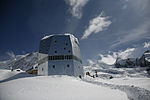Pollux (mountain)

Pollux (Italian: Polluce) is a mountain in the Pennine Alps on the border between Valais, Switzerland and the Aosta Valley in Italy. It is the lower of a pair of twin peaks (German: Zwillinge), the other being Castor, named after the Gemini twins of Roman mythology. Pollux' peak is at an elevation of 4,089 m (13,415 ft). It is separated from Castor by a pass at 3,846 m (12,618 ft), named Passo di Verra in Italian, Col de Verra in French and Zwillingsjoch in German. The first ascent was by Jules Jacot from Geneva with guides Josef-Marie Perren and Peter Taugwalder (father) on August 1 (the Swiss national day) 1864. Their route was via the Schwarztor, a pass first crossed by John Ball and Gabriel Zumtaugwald in 1845. The impressive north ridge was first climbed by Captain John Percy Farrar (a future President of the Alpine Club) and Wylie Lloyd with guide Josef Pollinger of St. Niklaus in the canton Valais on 18 August 1893. Ascents are usually made from the Refuge Ottorino Mezzalama (3,036 m), the Monte Rosa hut (2,795 m); if traversing the peaks via Pollux's north ridge, PD+, the Refuge Quintino Sella au Félik (3,585 m), and the Rossi-Volante bivouac hut (3,850 m). The first winter and ski ascent of Pollux was by Dr Alfred von Martin and Karl Planck on 7 March 1913.
Excerpt from the Wikipedia article Pollux (mountain) (License: CC BY-SA 3.0, Authors, Images).Pollux (mountain)
Canalino, Ayas
Geographical coordinates (GPS) Address Nearby Places Show on map
Geographical coordinates (GPS)
| Latitude | Longitude |
|---|---|
| N 45.927777777778 ° | E 7.7852777777778 ° |
Address
Madonnina del Polluce
Canalino
11020 Ayas
Aosta Valley, Italy
Open on Google Maps









